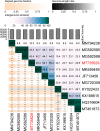Characterization and Genomic Analysis of BUCT549, a Novel Bacteriophage Infecting Vibrio alginolyticus With Flagella as Receptor
- PMID: 34220752
- PMCID: PMC8245777
- DOI: 10.3389/fmicb.2021.668319
Characterization and Genomic Analysis of BUCT549, a Novel Bacteriophage Infecting Vibrio alginolyticus With Flagella as Receptor
Abstract
Vibrio alginolyticus is one of the most important of pathogens that can infect humans and a variety of aquatic animals, and it can cause food poisoning and septicemia in humans. Widely used antibiotics are gradually losing their usefulness, and phages are gaining more attention as new antibacterial strategies. To have more potential strategies for controlling pathogenic bacteria, we isolated a novel V. alginolyticus phage BUCT549 from seafood market sewage. It was classified as a new member of the family Siphoviridae by transmission electron microscopy and a phylogenetic tree. We propose creating a new genus for BUCT549 based on the intergenomic similarities (maximum is 56%) obtained from VIRIDIC calculations. Phage BUCT549 could be used for phage therapy due to its stability in a wide pH (3.0-11.0) range and high-temperature (up to 60°C) environment. It had a latent period of 30-40 min and a burst size of 141 PFU/infected bacterium. In the phylogenetic tree based on a terminase large subunit, BUCT549 was closely related to eight Vibrio phages with different species of host. Meanwhile, our experiments proved that BUCT549 has the ability to infect a strain of Vibrio parahaemolyticus. A coevolution experiment determined that three strains of tolerant V. alginolyticus evaded phage infestation by mutating the MSHA-related membrane protein expression genes, which caused the loss of flagellum. This research on novel phage identification and the mechanism of infestation will help phages to become an integral part of the strategy for biological control agents.
Keywords: MSHA protein; bacteriophage; genome analysis; receptor; vibrio alginolyticus.
Copyright © 2021 Li, Tian, Hu, Lin, Liu, Zhao, Ren, Pan, Shi and Tong.
Conflict of interest statement
FZ, HR, and QP are from Qingdao Phagepharm Bio-tech Co., Ltd. The remaining authors declare that the research was conducted in the absence of any commercial or financial relationships that could be construed as a potential conflict of interest.
Figures









Similar articles
-
Characterization and Genomic Analysis of ValSw3-3, a New Siphoviridae Bacteriophage Infecting Vibrio alginolyticus.J Virol. 2020 May 4;94(10):e00066-20. doi: 10.1128/JVI.00066-20. Print 2020 May 4. J Virol. 2020. PMID: 32132234 Free PMC article.
-
Characterization of vB_ValM_PVA8, a broad-host-range bacteriophage infecting Vibrio alginolyticus and Vibrio parahaemolyticus.Front Microbiol. 2023 May 12;14:1105924. doi: 10.3389/fmicb.2023.1105924. eCollection 2023. Front Microbiol. 2023. PMID: 37250064 Free PMC article.
-
Characterization and genomic analysis of phage vB_ValR_NF, representing a new viral family prevalent in the Ulva prolifera blooms.Front Microbiol. 2023 May 5;14:1161265. doi: 10.3389/fmicb.2023.1161265. eCollection 2023. Front Microbiol. 2023. PMID: 37213492 Free PMC article.
-
Genomic analysis and biological characterization of a novel Schitoviridae phage infecting Vibrio alginolyticus.Appl Microbiol Biotechnol. 2023 Feb;107(2-3):749-768. doi: 10.1007/s00253-022-12312-3. Epub 2022 Dec 15. Appl Microbiol Biotechnol. 2023. PMID: 36520169
-
Phage Endolysins as Potential Antimicrobials against Multidrug Resistant Vibrio alginolyticus and Vibrio parahaemolyticus: Current Status of Research and Challenges Ahead.Microorganisms. 2019 Mar 18;7(3):84. doi: 10.3390/microorganisms7030084. Microorganisms. 2019. PMID: 30889831 Free PMC article. Review.
Cited by
-
Alginate-Encapsulated Mycobacteriophage: A Potential Approach for the Management of Intestinal Mycobacterial Disease.Viruses. 2023 Nov 22;15(12):2290. doi: 10.3390/v15122290. Viruses. 2023. PMID: 38140531 Free PMC article.
-
Isolation, characterization, and genomic analysis of a novel bacteriophage MA9V-1 infecting Chryseobacterium indologenes: a pathogen of Panax notoginseng root rot.Front Microbiol. 2023 Sep 14;14:1251211. doi: 10.3389/fmicb.2023.1251211. eCollection 2023. Front Microbiol. 2023. PMID: 37779709 Free PMC article.
-
Vibrio-infecting bacteriophages and their potential to control biofilm.Food Sci Biotechnol. 2023 Jun 19;32(12):1719-1727. doi: 10.1007/s10068-023-01361-7. eCollection 2023 Oct. Food Sci Biotechnol. 2023. PMID: 37780594 Free PMC article. Review.
-
Isolation and Characterization of a Newly Discovered Phage, V-YDF132, for Lysing Vibrio harveyi.Viruses. 2022 Aug 17;14(8):1802. doi: 10.3390/v14081802. Viruses. 2022. PMID: 36016424 Free PMC article.
-
Identification of novel genera and subcluster classifications for mycobacteriophages.Microbiome Res Rep. 2023 Jun 15;2(3):21. doi: 10.20517/mrr.2023.17. eCollection 2023. Microbiome Res Rep. 2023. PMID: 38046825 Free PMC article.
References
LinkOut - more resources
Full Text Sources

